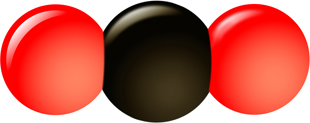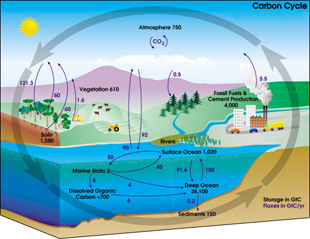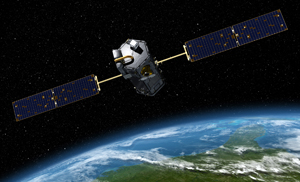The carbon cycle and us
What is the carbon cycle?Carbon is the chemical basis of all known life. It exists in forms as rare as diamond and more commonly as coal, and bonded with other atoms, in liquid and vapour forms. Humans are partly made up of carbon; after oxygen, carbon is the second most abundant element by mass in our bodies. The carbon cycle is the story both global and molecular, of how carbon atoms are transferred in various forms, through the atmosphere, oceans, plants, animals, soils and sediments.
CO2 molecule by Ingvald Straume CC BY-SA 3.0 Read an introduction to the carbon cycle by the ABC’s Bernie Hobbs, with an illustration of both ‘quick’ and ‘slow’ carbon cycles. NASA’s earth observatory also has an illustrated primer. Teaching the carbon cycleFind teacher-reviewed videos on the carbon cycle at NeoK12. The Climate Literacy and Energy Awareness network has digital resources for teachers on the carbon cycle (choose by grade). |
Animating the cycleUse an animation to illustrate steps of the carbon cycle in a simplified form, a short video, or a more detailed illustration from the site C02 CRC. Use another simple animation of each of the contributing parts of the cycle (requires Flash). NASA diagram of the carbon cycle View a larger version with an explanation. Resources for SecondaryTeach engineering has a lesson on carbon cycles, and Cycles of the Earth and Atmosphere has an excercise to explore the carbon cycle and be able to indentify carbon sources, sinks and release agents. The US National Science Foundation has a comprehensive video series on The Carbon Cycle. |
Carbon and climate changeThe Carbon Cycle Cartoon has a very clear explanation of the carbon cycle and humans' contribution to it. Visit the US Environmntal Protection Agency to Explore Climate Change Indicators and find units of work for Primary at the CSIRO's Education programs website. Find Secondary resources on the global carbon cycle on the C02 CRC Factsheets and Image gallery webpages.
NASA/JPL image. Artist concept of the planned Orbiting Carbon Observatory 2. In 2014 NASA plans to launch the Orbiting Carbon Observatory, to study atmospheric carbon. Investigate the pros and cons of introducing a price on carbon. David Suziki discusses the difference between a carbon tax and a cap-and-trade system. Find related resources with Sites2See: Exploring energy for Secondary and What is climate change?
|




